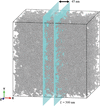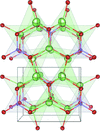issue contents
October 2021 issue

Cover illustration: Anisotropic displacement parameters (top), nuclear density distribution (middle) and bond valence mapping (bottom) as a function of temperature are used to visualize the Li-ion diffusion mechanism in Li3PO4. This information is useful for the study of the ionic transport mechanism in the crystal structure of a cathode or solid electrolyte for lithium-ion batteries. Courtesy of Manawan et al. [J. Appl. Cryst. (2021), 54, 1409–1415].
research papers
It is found that the Bayesian indirect Fourier transformation algorithm can accurately estimate the noise level of small-angle scattering data. This can be used to (i) evaluate whether experimental errors are over- or underestimated, (ii) rescale the experimental error estimates, and (iii) determine what reduced χ2 to aim for in model refinement.
Open  access
access
 access
accessA three-dimensional real-space model has been created for complex hierarchical materials by matching observed and simulated small-angle X-ray scattering patterns. The simulation is performed by arranging the positions of small primary particles and constructing an aggregate structure in a finite-sized cell.
A new and efficient method for the estimation of particle-size distribution from small-angle scattering data is presented. This method is based on features of the Porod plot.
The texture of the Ni monostanogermanide phase was studied by in situ X-ray diffraction, in-plane reciprocal space mapping and pole figure analysis. Sn addition modified the out-of-plane and in-plane orientations and reduced the number of texture components.
Download citation


Download citation


Unusual lateral structure deformations in a single crystal of potassium acid phthalate in an external electric field were found by X-ray diffraction techniques. Such deformations are shown to be due to the migration of disordered potassium cations in the structure.
CCDC reference: 2077599
Open  access
access
 access
accessA computational method that directly translates the scattering peak information to crystalline domain shapes and orientations is presented. The method is demonstrated at a synchrotron beamline with a standard X-ray scattering setup.
Good quality single crystals of ethyl p-hydroxybenzoate (EPHB) were successfully grown by the vertical Bridgman technique. Their properties were investigated to assess the potential applications of EPHB as a nonlinear optical material.
Download citation


Download citation


Open  access
access
 access
accessThis paper describes the design and implementation of an electric field sample cell, used to perform in situ single-crystal synchrotron X-ray diffraction under an applied electric field and suitable for single-crystal samples that are greater than 100 µm in size.
Open  access
access
 access
accessThis article focuses on the challenges of hit finding and data reduction in serial crystallography (SX). An effective and reliable Bragg-peak-finding method, called robust peak finder (RPF), has been developed. RPF is based on the principle of robust statistics and can be used for SX data analysis.
This paper investigates the development of texture and lattice stresses within polycrystalline rock salt under 1D compression loading and unconfined compression loading by means of in situ 3D synchrotron micro-computed tomography and 3D X-ray diffraction.
Open  access
access
 access
accessSmall-angle neutron scattering (SANS) is performed to analyse the microstructural state of a reference CuCrZr material with carefully controlled heat treatments, small-scale manufacturing mock-ups of assemblies and high-heat-flux-exposed mock-ups. The work demonstrates that SANS can be used for millimetre-scale analysis of small engineering components with minimal surface preparation.
Open  access
access
 access
accessThis paper investigates both analytically and experimentally the effect of the defocus (the difference between the splitter-to-mirror and analyser-to-mirror distances) on the phase of the travelling fringes in a separate-crystal triple-Laue X-ray interferometer.
The structure dynamics in Li3PO4 crystals are investigated using temperature-dependent neutron powder diffraction, which shows that the anisotropic displacement parameters, nuclear density distribution and bond valence map are subject to change with temperature. This information is useful for the study of lithium-ion diffusion in the crystal structure of a cathode or solid electrolyte for lithium-ion batteries.
A cost-effective high-temperature-compatible ConFlat electrochemical cell has been developed for in situ/operando X-ray diffraction studies of lithium-ion battery materials. Mechanical, electrochemical and operando X-ray diffraction measurements are presented.
A new grazing-incidence diffraction geometry between in plane and out of plane is proposed for simultaneous pole figure and residual stress measurement for polycrystalline thin films. Automatic data processing models are developed with refraction corrections implemented.
Open  access
access
 access
accessCombined non-ambient X-ray and neutron diffraction have been used to observe lattice parameter convergence in polar phases of the xBi(Zn2/3 Nb1/3)O3–(1 − x)BaTiO3 system below the ferroelectric composition limit at x < 5.0%. The lattice parameter convergence is correlated with peaks in the dielectric and piezoelectric coefficients.
Open  access
access
 access
accessPrecipitation experiments from a model Europan ocean solution subjected to fast and slow freezing suggest that the highly hydrated Na–Mg sulfate phase Na2Mg(SO4)2·16H2O is one of the lowest-temperature mineral phases likely to be stable on Europa's surface and may therefore be astrobiologically significant.
This paper discusses bias errors in phase fraction measurements that may occur when summing a series of complete Debye rings via transmission-based high-energy X-ray diffraction. Details of the errors, a method to make corrections to the data and a description of what crystallographic textures may be more problematic are included.
Open  access
access
 access
accessIt is now recognized that, beyond composition mapping in three dimensions, atom-probe tomography can provide partial crystallographic information for the material volume under investigation. Detailed here is an original solution for identifying the crystal structure and crystal orientations within atom-probe tomographic reconstructions. The reported tools are open-source software and scale strongly on at least 3200 computing cores or 160 graphics cards.
short communications
Bubble-induced crystal growth of indomethacin polymorphs not only depends on the interface created by the bubble but also strongly correlates with the true cavitation of the bubble.
Open  access
access
 access
accessA novel symmetry-adapted approach to analysing X-ray and neutron pair distribution function data is presented. Local deviations from the average structure are determined using representation analysis.
computer programs
reciprocalspaceship is a Python library for analyzing and manipulating reflection data from crystallography experiments. Using this library, it is possible to work interactively with crystallographic data, enabling easy integration with modern scientific computing libraries and supporting the rapid prototyping of new crystallographic methods and analyses.
The X-ray Server program for calculating dynamical X-ray diffraction from crystals with strained surface layers has been updated to run ten times faster, be more stable, output X-ray standing waves and more.
Open  access
access
 access
accessThe Pixel program can be run automatically by the Oscail package using either GAUSSIAN or Orca to calculate electron density.
addenda and errata
Open  access
access
 access
accessErrors and ambiguities in the article by Peterson, Olds, McDonnell & Page [J. Appl. Cryst. (2021), 54, 317–332] are corrected and clarified, respectively.


 journal menu
journal menu












































